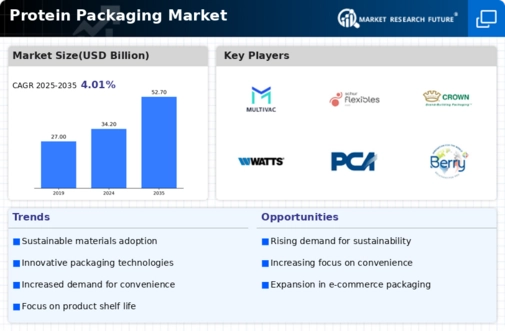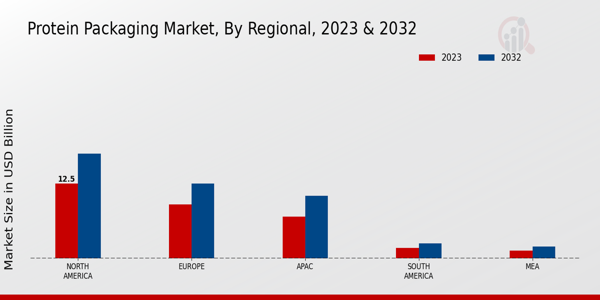Market Growth Projections
The Global Protein Packaging Market Industry is poised for substantial growth, with projections indicating a market value of 34.2 USD Billion in 2024 and an anticipated increase to 52.7 USD Billion by 2035. This growth trajectory suggests a compound annual growth rate (CAGR) of 4.01% from 2025 to 2035. Such figures underscore the increasing importance of protein products in consumer diets and the corresponding need for effective packaging solutions. As the market evolves, stakeholders must remain attuned to emerging trends and consumer preferences to capitalize on the opportunities presented by this expanding sector.
Health and Wellness Trends
The Global Protein Packaging Market Industry is significantly impacted by the growing health and wellness trends among consumers. As individuals prioritize fitness and nutrition, the demand for protein-enriched products continues to rise. This trend is evident in the increasing variety of protein-based snacks, supplements, and meal replacements available in the market. Manufacturers are responding to this demand by developing packaging that highlights nutritional information and promotes health benefits. By aligning product offerings with consumer preferences, brands can enhance their market presence and capitalize on the expanding health-conscious demographic.
Sustainability Initiatives
Sustainability emerges as a pivotal driver in the Global Protein Packaging Market Industry, as consumers increasingly favor eco-friendly packaging solutions. Manufacturers are adopting biodegradable and recyclable materials to align with environmental concerns. This shift not only meets consumer expectations but also complies with regulatory standards aimed at reducing plastic waste. The industry's commitment to sustainability is likely to influence purchasing decisions, as brands that prioritize eco-friendly practices may gain a competitive edge. Consequently, this trend could contribute to the market's growth, reflecting a broader societal shift towards sustainable consumption.
E-commerce Growth and Convenience
The rise of e-commerce significantly influences the Global Protein Packaging Market Industry, as consumers increasingly prefer the convenience of online shopping for protein products. This trend necessitates packaging that ensures product safety during transit while maintaining freshness. As online sales channels expand, manufacturers are compelled to innovate packaging solutions that cater to the unique challenges of e-commerce logistics. The convenience factor associated with online shopping is likely to drive demand for protein products, thereby contributing to the market's projected growth rate of 4.01% CAGR from 2025 to 2035.
Rising Demand for Protein Products
The Global Protein Packaging Market Industry experiences a notable surge in demand for protein-rich products, driven by increasing consumer awareness regarding health and nutrition. As individuals become more health-conscious, the preference for high-protein diets is evident. This trend is reflected in the market's projected value of 34.2 USD Billion in 2024, with expectations to reach 52.7 USD Billion by 2035. The growing popularity of protein supplements, snacks, and ready-to-eat meals necessitates innovative packaging solutions that preserve product integrity and extend shelf life, thereby enhancing the overall consumer experience.
Technological Advancements in Packaging
Technological innovations play a crucial role in shaping the Global Protein Packaging Market Industry. Advancements such as smart packaging, which includes features like freshness indicators and QR codes for traceability, enhance consumer engagement and product safety. These technologies not only improve the user experience but also help manufacturers optimize supply chain efficiency. As the industry evolves, the integration of automation and digital solutions is expected to streamline production processes, reduce costs, and improve packaging quality. This focus on technological enhancement positions the market for sustained growth in the coming years.














